24 days in Greece
bWFub2ZhZHZlbnR1cmU=bW9ja2JpdGVzLmNvbQ==Itinerary
Once again the odyssey began with a ticket to Athens, destination unknown. The itinerary below is not the starting point, it's a rewind after 24 days and 4,000km.
- Athens/Αθήνα
- Epidavros/Επίδαυρος
- Nafplio/Ναύπλιο
- Monemvasia/Μονεμβασιά
- Elafonisos/Ελαφόνησος
- Kythira/Κύθηρα
- Gythio/Γύθειο
- Diros/Διρός
- Mistras/Μυστράς
- Voidokilia/Βοιδοκοιλιά
- Zakynthos/Ζάκυνθος
- Kefalonia/Κεφαλλονιά
- Ithaki/Ιθάκη
- Lefkada/Λευκάδα
- Parga/Πάργα
- Kerkyra/Κέρκυρα
- Zagoroxoria/Ζαγωροχώρια
- Halkidiki/Χαλκιδική
- Thessaloniki/Θεσσαλονίκη
- Meteora/Μετέωρα
- Athens/Αθήνα
Introduction
Most rural roads in Greece are not numbered or otherwise named–the navigational cues you can expect are signs pointing the direction and distance to a particular city, so navigation involves a good map, awareness, and connecting the dots between departure and destination. Big cities like Athens have a well developed network of named roads with generally good signs. Having said that, driving around Athens is not for the faint of heart–a GPS navigation device is highly recommended, if not absolutely necessary. Since mid-2009 all the roads in Greece have been fully digitally mapped, however at the time of this trip only the streets of Athens were, so we bought a Greek road atlas on our third day in Athens. The prospect of using a booklet written in Greek is enough to make eyes cross and toes curl. Easy, now. Breathe. Outside the major roads, the signs are often in Greek only, so when trying to find east BF and you stop to ask the locals for directions having the map in Greek is an asset. Of course when you really get off the beaten path, there isn't always someone around. Welcome to Greece, and fasten your seatbelts.
Day 1
Athens/Αθήνα
We arrived in Athens at 09:00 directly from Philadelphia ready to roll. At the airport arrivals Christos/Χρήστος, from the rental car company, was waiting for us. Mom also arrived from Thessaloniki/Θεσσαλονίκη at about the same time. After hugs kisses and the obligatory tears from mom, Christos/Χρήστος took us to our car and we were on our way. Mom took the metro to grandma's and we headed to my cousins who I had not seen for ages.
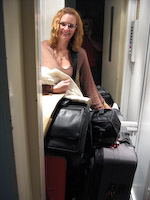 We made two pit-stops, one at an ATM for euros and one at a pastry
store to get a box of sweets for my cousins. I was delighted to see what great
kids my cousin Soula/Σούλα has raised as much as I enjoyed the giant beans she had prepared.
It's not that she's a good cook, which she is, it's her warmth, hospitality,
and joy to have us over. It's common in Greece, and it seems the less people
have, the more they want to give.
Time pressing, we headed for grandma's
around 15:00. Since grandpa passed away she has been living by herself in her
large rooftop apartment at Likavitos/Λυκαβητός. There we had the privilege
of ridding the world's smallest elevator. I remember this elevator since I was
a little kid, it worked like a mule even though we overloaded it with two and
a half tons of luggage–why is it that women pack for a month's trip as
if they are going away for at least a year? Agggh, never mind. After the
welcome niceties etc., Keleigh took a nap right on the sofa while I caught up with mom
and grandma. I was anxious to get out to Athens so I convinced grandma to join
us for a stroll in Psirri/Ψυρρή,
a cozy neighborhood near Monastiraki/Μοναστηράκι full
of eateries and music bars where a lot of the Athenians hang out.
We made two pit-stops, one at an ATM for euros and one at a pastry
store to get a box of sweets for my cousins. I was delighted to see what great
kids my cousin Soula/Σούλα has raised as much as I enjoyed the giant beans she had prepared.
It's not that she's a good cook, which she is, it's her warmth, hospitality,
and joy to have us over. It's common in Greece, and it seems the less people
have, the more they want to give.
Time pressing, we headed for grandma's
around 15:00. Since grandpa passed away she has been living by herself in her
large rooftop apartment at Likavitos/Λυκαβητός. There we had the privilege
of ridding the world's smallest elevator. I remember this elevator since I was
a little kid, it worked like a mule even though we overloaded it with two and
a half tons of luggage–why is it that women pack for a month's trip as
if they are going away for at least a year? Agggh, never mind. After the
welcome niceties etc., Keleigh took a nap right on the sofa while I caught up with mom
and grandma. I was anxious to get out to Athens so I convinced grandma to join
us for a stroll in Psirri/Ψυρρή,
a cozy neighborhood near Monastiraki/Μοναστηράκι full
of eateries and music bars where a lot of the Athenians hang out.
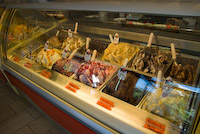 Talk about doing things backwards–we were not
very hungry so we first went to Gelatomania, the most tempting ice-cream
shop I have ever been to. It's located at the corner of Taki 21 & Aisopou/Τάκη 21 & Αισώπου,
a bit of a chore to find but worth the effort. We did not
see many tourists there, although apparently it's well known amongst the locals,
and it should be. It's as good as the legendary Deliolanis/Δεληολάνης shop I
went to as a kid in Glyfada/Γλυφάδα. After we licked our chops clean we met
with my brother Kosta/Κώστα. The sugar rush increased our appetite, so we searched
for Taverna tou Psirri/Ταβέρνα του Ψυρρή and we found it at
Aisxylou/Αισχύλου 12. It felt good to finally have a good Greek salad along with beans, stuffed
tomatoes, and passionate talk about life, relationships, and the unknown; until
grandma was ready to go home, she seemed to be more tired than us, but she's
grandma and we love her.
Talk about doing things backwards–we were not
very hungry so we first went to Gelatomania, the most tempting ice-cream
shop I have ever been to. It's located at the corner of Taki 21 & Aisopou/Τάκη 21 & Αισώπου,
a bit of a chore to find but worth the effort. We did not
see many tourists there, although apparently it's well known amongst the locals,
and it should be. It's as good as the legendary Deliolanis/Δεληολάνης shop I
went to as a kid in Glyfada/Γλυφάδα. After we licked our chops clean we met
with my brother Kosta/Κώστα. The sugar rush increased our appetite, so we searched
for Taverna tou Psirri/Ταβέρνα του Ψυρρή and we found it at
Aisxylou/Αισχύλου 12. It felt good to finally have a good Greek salad along with beans, stuffed
tomatoes, and passionate talk about life, relationships, and the unknown; until
grandma was ready to go home, she seemed to be more tired than us, but she's
grandma and we love her.
Day 2
Athens/Αθήνα
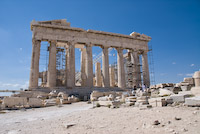 After
a good night sleep, fed and armed with cameras maps water and smiles, we were
ready for a tour of the Acropolis. We took the metro to Monastiraki/Μοναστηράκι
and entered the site from the Ancient Market/Αρχαία Αγορά where we briefly visited
the museum before ascending to the foothills of Acropolis. We hired Sophia/Σοφία, a
French history student that works as a licensed guide, to give us a historical
account of what we, or at least I, should have remembered from school. I couldn't
help zoning in to her every word time traveling 2,500 years back reliving the
Athenian experience. I am honored to be from this city.
After
a good night sleep, fed and armed with cameras maps water and smiles, we were
ready for a tour of the Acropolis. We took the metro to Monastiraki/Μοναστηράκι
and entered the site from the Ancient Market/Αρχαία Αγορά where we briefly visited
the museum before ascending to the foothills of Acropolis. We hired Sophia/Σοφία, a
French history student that works as a licensed guide, to give us a historical
account of what we, or at least I, should have remembered from school. I couldn't
help zoning in to her every word time traveling 2,500 years back reliving the
Athenian experience. I am honored to be from this city.
After the tour we relaxed near the Parthenon enjoying the scenery and made new friends, Sue and Bob, a couple from San Diego. We invited them to join us for lunch to Platanos/Πλάτανος an old taverna next to the Acropolis in Plaka/Πλάκα at Diogenous/Διογένους 4. It's not trendy or touristy like other places, but it's a gem. Interesting enough, the word platanos/πλάτανος means plane-tree, and there is a popular Greek saying “χαιρέτα μας τον πλάτανο” (wave the plane-tree goodbye) which actually refers to the plane-tree outside this taverna; back in the old days there used to be a prison near by, and it was customary when an inmate was about to be released for others to ask him to say goodbye to the tree for them. Nowadays the phrase is a tease for someone who gives unfulfilled promises. Yet, the promise of good mousaka/μουσακά at this taverna is very real! For dessert I issued a decree: “We are going to Gelatomania; you won't regret it” They didn't. “Mmmm, aaaaah, gooood”, yes, I know, I know. Keleigh almost locked herself in the bathroom, more about that later.
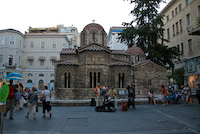 We soon returned to Monastiraki/Μοναστηράκι walking Ermou/Ερμού
street up towards the parliament passing an endless array of stores
with the latest fashion designs. They say diamonds are a girl's best friend, but
on Ermou it's a Mastercard. There are so many good shops there, but my favorite
is Berto Lucci, an upscale men's clothing store–don't let the Italian
name fool you–their clothes are designed and made in Greece, top quality.
We waved our friends Sue and Bob goodbye to their hotel, the Grande Bretagne,
and walked across from from Syntagma square/Πλατεία Συντάγματος to the
Tomb of the Unknown Soldier/Μνημείο του Άγνωστου Στρατιώτη
in front of the parliament to watch the changing of the guard. There
is an old Greek saying: “We choose an hour of free life over forty years of
slavery and prison”.
This tomb is a symbolic war grave for the soldiers that sacrificed themselves
so we can enjoy freedom.
We soon returned to Monastiraki/Μοναστηράκι walking Ermou/Ερμού
street up towards the parliament passing an endless array of stores
with the latest fashion designs. They say diamonds are a girl's best friend, but
on Ermou it's a Mastercard. There are so many good shops there, but my favorite
is Berto Lucci, an upscale men's clothing store–don't let the Italian
name fool you–their clothes are designed and made in Greece, top quality.
We waved our friends Sue and Bob goodbye to their hotel, the Grande Bretagne,
and walked across from from Syntagma square/Πλατεία Συντάγματος to the
Tomb of the Unknown Soldier/Μνημείο του Άγνωστου Στρατιώτη
in front of the parliament to watch the changing of the guard. There
is an old Greek saying: “We choose an hour of free life over forty years of
slavery and prison”.
This tomb is a symbolic war grave for the soldiers that sacrificed themselves
so we can enjoy freedom.
That night instead of staying at grandma's we checked in to Amalia Hotel, right next to Syntagma square/Πλατεία Συντάγματος and the parliament. That gave us a head start for day 3. Great hotel and location, recommended.
Day 3
Athens/Αθήνα
After another relaxing night and a robust breakfast we walked Panepistimiou/Πανεπιστημίου
street passing the Academy of Athens,
the University of Athens, and the National
Library all the way down to Omonia/Ομόνοια square
and then on to the archaeological museum at Patision/Πατησίων 44.
Its ground floor is filled with sculptures in bronze and marble–the bronze
collection is one the largest
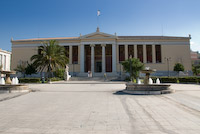 in the world; famous for its large-scale original statues of
Poseidon or ZeusArchaeologists are divided regarding the identity.
from Artemision/Aρτεμίσιον. This level also has an Egyptian collection including
mummies, statues, pottery, and jewelry. The second floor is filled with vases
and minor arts. The basement's garden is surrounded by beautiful sculptures
and is a great place to rest or have a snack while enjoying the tranquility
of the surroundings. After our museum visit we took a short metro ride from
the Omonia/Ομόνοια square to the Syntagma square/Πλατεία Συντάγματος to check out of
Amalia Hotel, and headed back to grandma’s with a quick pit stop at the Panathinaiko/Παναθηναικό
stadium. This was the home of the first modern Olympiad in 1896, and it stands
out for its simple yet superb architecture.
in the world; famous for its large-scale original statues of
Poseidon or ZeusArchaeologists are divided regarding the identity.
from Artemision/Aρτεμίσιον. This level also has an Egyptian collection including
mummies, statues, pottery, and jewelry. The second floor is filled with vases
and minor arts. The basement's garden is surrounded by beautiful sculptures
and is a great place to rest or have a snack while enjoying the tranquility
of the surroundings. After our museum visit we took a short metro ride from
the Omonia/Ομόνοια square to the Syntagma square/Πλατεία Συντάγματος to check out of
Amalia Hotel, and headed back to grandma’s with a quick pit stop at the Panathinaiko/Παναθηναικό
stadium. This was the home of the first modern Olympiad in 1896, and it stands
out for its simple yet superb architecture.
After a delicious gyro/γύρο from Grandpa's pita/Πίτα του παππού it was time to say good bye to Athens for now, and head out to Peloponnisos/Πελοπόννησος. We took the shortest route straight through Athens in Friday afternoon traffic instead of taking the ring road. I made a mental note not to do that again. The drive along the northeast coast of Peloponnisos/Πελοπόννησος is pleasant and eventually leads to perhaps the most famous Greek ancient theater.
Epidavros/Επίδαυρος
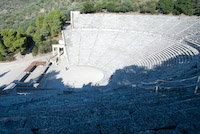 Epidavros is famous for its ancient 12,000 seat theater, in operation for
2,300 years! It is camouflaged by the ground morphology as there are no indicators
you are near such significant structure even after arriving to the area. According
to Pausanias/ΠαυσανίαςGreek traveler and geographer of the 2nd century BC.
it was built around 300 BC, yet the acoustics are so good that the performers can whisper and still be heard
in the last row.
Epidavros is famous for its ancient 12,000 seat theater, in operation for
2,300 years! It is camouflaged by the ground morphology as there are no indicators
you are near such significant structure even after arriving to the area. According
to Pausanias/ΠαυσανίαςGreek traveler and geographer of the 2nd century BC.
it was built around 300 BC, yet the acoustics are so good that the performers can whisper and still be heard
in the last row.
Unfortunately we missed the summer performing season, but we were entertained by a group of German teenagers who kept singing to the dismay of the groundskeepers. After the mini concert we took a quick tour of the small museum. From there we headed south-west towards Nafplio/Ναύπλιο.
Nafplio/Ναύπλιο
Nafplio/Ναύπλιο was the first capital of the modern Greek state from 1829 to 1834. The old town was built at the beginning of the 19th century, during the leadership of Ioannis Kapodistrias/Ιωάννης Καποδίστριας the first governor after independence from the Turks. Kapodistrias/Καποδίστριας did well to organize the government after 400 years of Ottoman occupation, but he underestimated the power of the clans that led the war of independence in 1821, and who had expected a leadership role. Sadly, he was assassinated at Nafplio/Ναύπλιο in 1831.
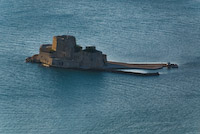 One of the most impressive sites in the city is the Venetian
castle Palamidi/Παλαμίδι hovering
216 meters high over the city. It was built by engineers La Salle and Giaxich
in the 17th century. There are 857 steps from the town to the castle, and over
a thousand to reach the top so we took the easy way and drove up. Unfortunately
we got there half an hour before closing time, nevertheless we arrived in the
best time to enjoy the view of the harbor and the Bourtzi/Μπούρτζι fortress as the sun
was setting. After a quick tour we went inside the Miltiades/Μηλτιάδη bastion where
Theodoros Kolokotronis/Θεόδωρος Κολοκοτρώνης,
hero of the Greek war of independence, was imprisoned.
The cell was pitch-dark and as tiny as the entrance to it, I barely fit kneeling
in. Often that's the thank you heroes get, only to be celebrated
later as he is today in Greece.
One of the most impressive sites in the city is the Venetian
castle Palamidi/Παλαμίδι hovering
216 meters high over the city. It was built by engineers La Salle and Giaxich
in the 17th century. There are 857 steps from the town to the castle, and over
a thousand to reach the top so we took the easy way and drove up. Unfortunately
we got there half an hour before closing time, nevertheless we arrived in the
best time to enjoy the view of the harbor and the Bourtzi/Μπούρτζι fortress as the sun
was setting. After a quick tour we went inside the Miltiades/Μηλτιάδη bastion where
Theodoros Kolokotronis/Θεόδωρος Κολοκοτρώνης,
hero of the Greek war of independence, was imprisoned.
The cell was pitch-dark and as tiny as the entrance to it, I barely fit kneeling
in. Often that's the thank you heroes get, only to be celebrated
later as he is today in Greece.
After Palamidi/Παλαμίδι we descended to the city and wondered around Staikopoulou/Σταϊκοπούλου street where there are many small shops worth visiting. Just off the main street is the church of Agios Spyridonas/Αγίου Σπυρίδωνα outside of which Kapodistrias/Καποδίστριας was assassinated. One of the bullets that missed stuck in the church's wall where it's still visible today.
We picked the tavern Markezinis/Μαρκεζίνης for dinner and talked to the owner. Apparently decades ago he had served the politician Spyro Markezini/Σπύρο Μαρκεζίνη who had tipped him 500 drachmas, a small fortune at the time, and he decided to name the tavern after him. The food was good, and it became even better by following it up with ice-cream on Rebani/Ρεβανί at the nearby patisserie. Castles? what castles? this alone is worth the visit.
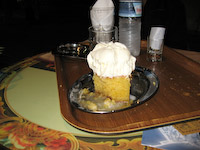 However, it was here that I made the first unforced error in my
daily pursuit of getting the best accommodations. Excluding high season, you
don't have to plan for hotels. The process of sniffing the best hotels with
little or no prior information can for some make the hair on the back of their
neck stand on end, especially when it goes all wrong. I was not satisfied with
the hotels we visited in the city and decided to roll the dice heading south
towards Monemvasia/Μονεμβασιά, surely, I thought,
there would be a nice hotel on the way. Kilometer after kilometer there was
no soul other than absolute darkness. Around 23:00
we found the village of Astros/Άστρος and circled it twice looking for a hotel before
stopping at the village square where I chatted up a couple of lads who were
chilling out sipping their coffeeHanging out and drinking coffee is one of Greece's national pastimes..
They sent us to Astros Βeach/Παράλιο Άστρος where
we found Maria Studios. For €50 we had the keys
to a room with TV and I could finally watch Greece vs Slovenia for EuroBasket
2007. After being 16 points behind with 7 minutes to go, and then 7 points behind with
50 seconds to go, I turned off the TV disgusted and went to sleep.
However, it was here that I made the first unforced error in my
daily pursuit of getting the best accommodations. Excluding high season, you
don't have to plan for hotels. The process of sniffing the best hotels with
little or no prior information can for some make the hair on the back of their
neck stand on end, especially when it goes all wrong. I was not satisfied with
the hotels we visited in the city and decided to roll the dice heading south
towards Monemvasia/Μονεμβασιά, surely, I thought,
there would be a nice hotel on the way. Kilometer after kilometer there was
no soul other than absolute darkness. Around 23:00
we found the village of Astros/Άστρος and circled it twice looking for a hotel before
stopping at the village square where I chatted up a couple of lads who were
chilling out sipping their coffeeHanging out and drinking coffee is one of Greece's national pastimes..
They sent us to Astros Βeach/Παράλιο Άστρος where
we found Maria Studios. For €50 we had the keys
to a room with TV and I could finally watch Greece vs Slovenia for EuroBasket
2007. After being 16 points behind with 7 minutes to go, and then 7 points behind with
50 seconds to go, I turned off the TV disgusted and went to sleep.
Day 4
Monemvasia/Μονεμβασιά
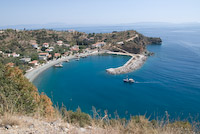 As I opened the window in the morning—it overlooked a pretty garden—I
was greeted by a gorgeous sunny day, it felt good. I casually turned the TV
back on while getting ready, and miracle of miracles, again! After the ridiculous
comeback against the French in the 2005 EuroBasket, the Greek players had decided
to do it again, sending heart patients running for their medication in the
process. Greece was in the final four, and I was all smiles while driving.
As I opened the window in the morning—it overlooked a pretty garden—I
was greeted by a gorgeous sunny day, it felt good. I casually turned the TV
back on while getting ready, and miracle of miracles, again! After the ridiculous
comeback against the French in the 2005 EuroBasket, the Greek players had decided
to do it again, sending heart patients running for their medication in the
process. Greece was in the final four, and I was all smiles while driving.
Somewhere up in the mountains on the way to Monemvasia/Μονεμβασιά I noticed a sign for the small church of St. Dimitrios/Άγιος Δημήτριος and decided to check it out. It was located to the left of the main road about 1Km from it. I was surprised to see two firemen right outside the church repairing their firetruck—Greece had just gone through one of the worst ever fire seasons with most of Peloponnisos/Πελοπόννησος engulfed in flames—firemen all over Greece were on high alert. It turned out that one of them had worked in Baltimore for a couple of years, what a small world. After a brief visit to the interior of the church I thanked them for their dedication and hard work, and we restarted our heading south to Monemvasia/Μονεμβασιά.
A well-known medieval castle, Monemvasia/Μονεμβασιά, lies on a small island off the east coast of Peloponnisos/Πελοπόννησος in the prefecture of Laconia/Λακωνία. Its name is derived from the Greek words μόνη έμβαση, which means single entrance. Driving across the bridgeBuilt in 1971. we were struck by the steepness of the terrain. “The rock” is 300 meters high 1.8km long and the village is located on its southeastern side on a plateau. True to its name, there is a single entrance to the castle leading to a long narrow cobblestone pathway with shops, hotels, tavernas, and amazing views on either side. At the heart of the village is its cathedral—Elkomenos Christos/Έλκόμενος Χριστός—the largest of its 40 churches.
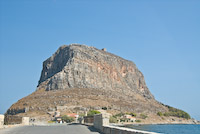 We made our way to the far end of the village discovering
Malvasia hotel, it's worth the trip from the
castle gate, especially if you tip a bellboy to carry the luggage.
Our suite had the look and feel of living in a castle with the modern conveniences of
separate bedrooms, a big bathroom, satellite TV, internet, and an outstanding view.
Anna/Άννα decided to rest while we went exploring climbing the small cliff
behind our room to a watch tower of the castle perimeter wall. Once we managed to climb onto the
watch towerA task not so easy as there are no stairs.
and back out the other side we were rewarded with a beautiful high vantage view of the village.
For dinner we ate at the tavern Kanoni/Κανόνι which overlooks the church of
Elkomenos Christos/Έλκόμενος Χριστός—along with the tasty local specialties
we witnessed a wedding held just below us.
We made our way to the far end of the village discovering
Malvasia hotel, it's worth the trip from the
castle gate, especially if you tip a bellboy to carry the luggage.
Our suite had the look and feel of living in a castle with the modern conveniences of
separate bedrooms, a big bathroom, satellite TV, internet, and an outstanding view.
Anna/Άννα decided to rest while we went exploring climbing the small cliff
behind our room to a watch tower of the castle perimeter wall. Once we managed to climb onto the
watch towerA task not so easy as there are no stairs.
and back out the other side we were rewarded with a beautiful high vantage view of the village.
For dinner we ate at the tavern Kanoni/Κανόνι which overlooks the church of
Elkomenos Christos/Έλκόμενος Χριστός—along with the tasty local specialties
we witnessed a wedding held just below us.
The early morning welcomed us with the sound of the waves crashing against the castle wall and a gorgeous sunrise–I felt dejavu from my childhood days, rising early to go fishing with my dad in Halkidiki/Χαλκιδική. We hit the road by 08:00 and made a stop in the city of Monemvasia/Μονεμβασιά at a sweets factory to buy the local delicacy almond sweets/αμυγδαλωτά which are delicious! It was election day in Greece, but instead going back to Athens to vote, we were heading for Vigklafia/Βιγκλάφια to catch the ferry to Elafonisos/Ελαφόνησος.
Day 5
Elafonisos/Ελαφόνησος
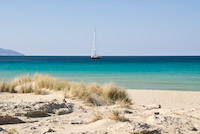 Elafonisos/Ελαφόνησος is a small island between Peloponnisos/Πελοπόννησος
and the island of Kythira/Κύθηρα with just over 300 inhabitants.
During the short ferry ride I talked to a girl and her mother who were going to an event at
Agios Spyridon/Άγιος Σπυρίδων—the main church of the community, built on a tiny piece
of land that is connected to the rest of the island by a bridge over shallow waters.
The island is not very touristy—upon our arrival we felt the quaint atmosphere—but it's worth
a visit for a swim.
Elafonisos/Ελαφόνησος is a small island between Peloponnisos/Πελοπόννησος
and the island of Kythira/Κύθηρα with just over 300 inhabitants.
During the short ferry ride I talked to a girl and her mother who were going to an event at
Agios Spyridon/Άγιος Σπυρίδων—the main church of the community, built on a tiny piece
of land that is connected to the rest of the island by a bridge over shallow waters.
The island is not very touristy—upon our arrival we felt the quaint atmosphere—but it's worth
a visit for a swim.
After a pit stop to a store for a Sprite to calm down Keleigh's upset stomach, we headed to the south side of the island to its main attraction, Simos/Σίμος beach, a long white sand beach with unreal turquoise water. The coolness of the water was a bit of a shock to Keleigh, who has been spoiled by the super warm waters of the Virgin Islands; Anna/Άννα and I were in the water in no time. After a satisfying hour at the beach we scrambled to catch the 11:40 ferry for Vigklafia/Βιγκλάφια.
Kythira/Κύθηρα
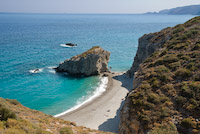 Upon arrival to Vigklafia/Βιγκλάφια we hastingly left for
Neapoli/Νεάπολη to catch the 13:00 ferry for Kythira/Κύθηρα.
After about an hour at sea we arrived to a port that is actually on the small
island of Makronisi/Μακρονήσι which is connected
with Kythira/Κύθηρα by a bridge. Nearby is the islet of
Prasonisi/Πρασονήσι where some unfortunate captain managed to “park” his ship—I almost had the same fate off-roading our 4 door sedan off, way off the beaten path
towards Kaladi/Καλαδί beach. We parked on a cliff overlooking the water,
and descended a rather steep but pleasant trail down to the beach—it was beautiful
yet so remote that few people were around.
We took the left section all to ourselves and enjoyed the crystal clear water and the warm sun, it was well worth
the trek getting there.
Upon arrival to Vigklafia/Βιγκλάφια we hastingly left for
Neapoli/Νεάπολη to catch the 13:00 ferry for Kythira/Κύθηρα.
After about an hour at sea we arrived to a port that is actually on the small
island of Makronisi/Μακρονήσι which is connected
with Kythira/Κύθηρα by a bridge. Nearby is the islet of
Prasonisi/Πρασονήσι where some unfortunate captain managed to “park” his ship—I almost had the same fate off-roading our 4 door sedan off, way off the beaten path
towards Kaladi/Καλαδί beach. We parked on a cliff overlooking the water,
and descended a rather steep but pleasant trail down to the beach—it was beautiful
yet so remote that few people were around.
We took the left section all to ourselves and enjoyed the crystal clear water and the warm sun, it was well worth
the trek getting there.
Fresh from the hotel debacle at Nafplio/Ναύπλιο I decided to find a hotel sooner rather than later, so we looked in the capital Xora/ΧώραThe capital of most Greek islands can be referred to as Xora/Χώρα even if it has a specific name. and the nearby town of Kapsali/Καψάλι to no avail. I temporarily abandoned the search and drove us to the monastery of St. Elessa/Αγία Ελέσσα up in the mountain on the southwest side of the island. We met an old priest, the only person there, who was both happy and kind to tell us about the monastery which is dedicated to the martyr St. Elessa/Αγία Ελέσσα. She was murdered by her father, an idol worshipper/ειδωλολάτρης, because she would not renounce her Christian faith. Before leaving the priest wrote the names of our loved ones and promised to mention them during the next liturgy. Inspired yet hungry and tired the search for food and board began anew.
Intuition lead us north to Potamos/Ποταμός, then to St. Pelagia/Αγία Πελαγία straight to the only four star hotel of the island, Kythea Resort, freshly built just two months prior. If it's there, I'll find it. The resort receptionist recommended the taverna Kaleris/Καλέρης near the water. Food at last... NOT! We arrived at the taverna only to realize I had forgotten my wallet back in our room. Horror of horrors! Anna/Άννα talked to the owner asking if we can pay with her credit card. No dice, they did not accept credit cards, but he welcomed us to eat and pay the following day. Only in Greece.
Day 6
Kythira/Κύθηρα
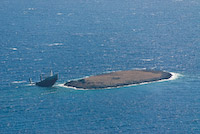 Next morning the resort staff had prepared a robust breakfast with freshly squeezed orange juice. Before
waving this hospitable place good-bye, we stopped at taverna Kaleris/Καλέρης to pay our
debt and thank the owner, and off we were for the Fairy/Νεράϊδα waterfalls at
Mylopotamos/Μυλοπόταμος. Unfortunately there was hardly any running water
to do justice to the scenery, nevertheless the short hike down to the creek was enjoyable.
Next morning the resort staff had prepared a robust breakfast with freshly squeezed orange juice. Before
waving this hospitable place good-bye, we stopped at taverna Kaleris/Καλέρης to pay our
debt and thank the owner, and off we were for the Fairy/Νεράϊδα waterfalls at
Mylopotamos/Μυλοπόταμος. Unfortunately there was hardly any running water
to do justice to the scenery, nevertheless the short hike down to the creek was enjoyable.
The plan was to catch the 11:00 ferry back to Neapoli/Νεάπολη and since we had some time, despite protests from Anna/Άννα, we ascended one of the island's highest mountains to the monastery of St. Moni/Αγία Μόνη. We gazed at the majestic view of the Prasonisi/Πρασονήσι shipwreck and with few minutes to spare we raced down the mountain just in time to buy tickets and drive onto the ferry.
Gythio/Γύθειο
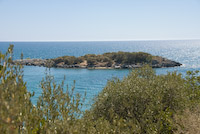 I had a treat up my sleeve for the girls, so upon our arrival back to the mainland we drove westwards
to the middle peninsula of Peloponnisos/Πελοπόννησος.
After Vlachiotis/Βλαχιώτης near Gythio/Γύθειο
we came upon yet another shipwreck on one of the beaches—despite the rusty evidence of
the drama her crew must have gone through, today it adds color and mystique to the scenery.
I had a treat up my sleeve for the girls, so upon our arrival back to the mainland we drove westwards
to the middle peninsula of Peloponnisos/Πελοπόννησος.
After Vlachiotis/Βλαχιώτης near Gythio/Γύθειο
we came upon yet another shipwreck on one of the beaches—despite the rusty evidence of
the drama her crew must have gone through, today it adds color and mystique to the scenery.
We continued on to Gythio/Γύθειο and drove onto the pretty island of Karanai/ΚαρανάηAlso known as Marathonisi/Μαραθονήσι.. On the small island is the Tzanetaki/ΤζανετάκηOwned by the family, of political fame, Tzanetaki/Τζανετάκη. tower, operating today as a historic and ethnic museum for the greater area of Mani/Μάνη. We were so hungry we forgoed the tower in favor of the delightful Taverna Island/Ταβέρνα Νησί. Their stuffed tomatoes and peppers dish was excellent, recommended.
Diros/Διρός
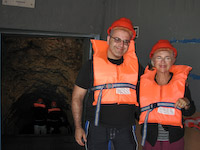 Our next stop was supposed to be a beach
on the other side of the peninsula near Areopoli/Αρεόπολη, and I had
everybody conned right until we pulled into parking lot of the
famous Diros/Διρός caves.
The caves are part of an underground river, and the 5000 meters that have been exposed are fascinating.
From the entrance skillful whistling gondoliers steer small boats over
crystal clear water through narrow passageways,
around beautiful formations of stalagmites and stalactites, their colors created by rain water
penetrating the calcium carbonate in the rock.
Our next stop was supposed to be a beach
on the other side of the peninsula near Areopoli/Αρεόπολη, and I had
everybody conned right until we pulled into parking lot of the
famous Diros/Διρός caves.
The caves are part of an underground river, and the 5000 meters that have been exposed are fascinating.
From the entrance skillful whistling gondoliers steer small boats over
crystal clear water through narrow passageways,
around beautiful formations of stalagmites and stalactites, their colors created by rain water
penetrating the calcium carbonate in the rock.
The caves have served as places of worship in Paleolithic and Neolithic times—they are thought by many to be connected to the Underworld. The temperature inside the cave is a constant 16 °C air, 12 °C water, year round. From the coolness of the cave we got back to the summer heat of the car and started driving north towards Mistras/Μυστράς.
Mistras/Μυστράς
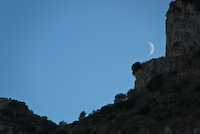 We took a shortcut bypassing Sparti/Σπάρτη in an effot to be at
the castle before dusk, but still arrived only half hour before closing—not
enough time for a tour—so we decided to come back in the morning. I
researched the local accommodations and quickly found the magnificent
Pyrgos of Mystras/Πύργος του Μυστρά,
an 18th century mansion that was converted into a luxury hotel by its current owners. Small
and cute just the way it ought to be, recommended.
We took a shortcut bypassing Sparti/Σπάρτη in an effot to be at
the castle before dusk, but still arrived only half hour before closing—not
enough time for a tour—so we decided to come back in the morning. I
researched the local accommodations and quickly found the magnificent
Pyrgos of Mystras/Πύργος του Μυστρά,
an 18th century mansion that was converted into a luxury hotel by its current owners. Small
and cute just the way it ought to be, recommended.
After settling in our rooms, Keleigh and I walked to the main village square and paid a visit to the taverna our hostess Maria suggested, once again the food did not disappointIt rarely does in Greece; however, the States are full of Greek cuisine wannabes with notable exceptions of the Stamatis and Cyclades tavernas in Astoria NY.. Before falling dead in bed from this interesting but tiring day we hooked up to internet and watched TVVia a slingbox from the States.
Day 7
Mistras/Μυστράς
We started the day with a satisfying breakfast at the hotel before returning to the castle which is
on the north side of Mt. Taigetos/Ταύγετος at the top of the
Mistras/Μυστράς hill. Inside the castle lie six centuries of a rich and significant
historic journey that kept the Greek civilization alive through its ups and downs. The fort was build
by Frankish prince Guillaume de Villehardouin/Γουλιέλμος Βιλεαρδουίνος
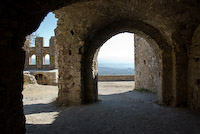 in 1249 in an attempt to establish his supremacy over
Peloponnisos/Πελοπόννησος,
but his defeat at Pelagonia/Πελαγονία in 1259 forced the Franks to return it
to the Byzantines. Under the Katakouzinos/Κατακουζηνός and
Paleologos/Παλαιολόγος emperors
it was transformed into a Byzantine castle city with palaces, mansions, glorious churches and monasteries—it was
a significant cultural center as well as
the capital of Despotate
of Morea/Μοριά1348-1460..
Seven years after the fall of Constantinople/Κωνσταντινούπολη1453. to the Ottomans,
Dimitrios Paleologos/Δημήτριος Παλαιολόγος,
the last despot of Morea/Μοριά,
surrendered the city to Ottoman emperor Mehmed II. In the 17th century it was captured
by the Venetians, but the Ottomans returned in 1715. The castle city managed to preserve itself until 1825 when
it was completely destroyed by the army of Egyptian general Ibrahim Pasha/Ιμπραήμ Πασά
who tried to squelch the Greeks' fight for independence. He was ultimately defeated in the naval
battle of Navarino/Ναυαρίνο,
but Mistras/Μυστράς was deserted and nobody ever lived in it again
as the new city of Sparti/Σπάρτη was later built nearby.
in 1249 in an attempt to establish his supremacy over
Peloponnisos/Πελοπόννησος,
but his defeat at Pelagonia/Πελαγονία in 1259 forced the Franks to return it
to the Byzantines. Under the Katakouzinos/Κατακουζηνός and
Paleologos/Παλαιολόγος emperors
it was transformed into a Byzantine castle city with palaces, mansions, glorious churches and monasteries—it was
a significant cultural center as well as
the capital of Despotate
of Morea/Μοριά1348-1460..
Seven years after the fall of Constantinople/Κωνσταντινούπολη1453. to the Ottomans,
Dimitrios Paleologos/Δημήτριος Παλαιολόγος,
the last despot of Morea/Μοριά,
surrendered the city to Ottoman emperor Mehmed II. In the 17th century it was captured
by the Venetians, but the Ottomans returned in 1715. The castle city managed to preserve itself until 1825 when
it was completely destroyed by the army of Egyptian general Ibrahim Pasha/Ιμπραήμ Πασά
who tried to squelch the Greeks' fight for independence. He was ultimately defeated in the naval
battle of Navarino/Ναυαρίνο,
but Mistras/Μυστράς was deserted and nobody ever lived in it again
as the new city of Sparti/Σπάρτη was later built nearby.
Today it stands as a romantic reminder of a glorious past, a symbol of Morea/Μοριά, the last stronghold of the Byzantine dynasty, and the beginning of the Greek Revolution against the Ottomans which after heroic struggles and sacrifices from Greeks and Philhellenes/Φιλέλληνες lead to the first independent Greek state in 1829.
Voidokilia/Βοιδοκοιλιά
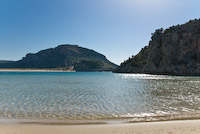 From Mistras/Μυστράς we climbed
over Mt. Taigetos/Ταύγετος through countless
switchbacks to the city of
Kalamata/Καλαμάτα, were the world famous olives are produced—we
reloaded on euros one last time before continuing on to the
Ionian/Ιόνιο islands.
From Mistras/Μυστράς we climbed
over Mt. Taigetos/Ταύγετος through countless
switchbacks to the city of
Kalamata/Καλαμάτα, were the world famous olives are produced—we
reloaded on euros one last time before continuing on to the
Ionian/Ιόνιο islands.
An hour and a half later we were taking a dip at the cool crystal clear waters of Voidokilia/Βοιδοκοιλιά beach—its name in Greek literally means cow's stomach, presumably because of its circular shape. This beach is located just north of the city of Pylos/Πύλος and Navarino/Ναυαρίνο bay, site of the 1827 naval battle where the combined Ottoman and Egyptian armada was destroyed.
Zakynthos/Ζάκυνθος
Following our swim we had a 2½ hour drive north to the beach town of Kyllini/Κυλλήνη through Andravída/Ανδραβίδα where my father had served in the airforce—today Andravída/Ανδραβίδα Air Force Base is home of HAF's 117 Combat Wing.
The next ferry for Zakynthos/Ζάκυνθος was departing at 21:30, allowing enough time
for dinner at taverna Sou Mou/Σου Μου located right at the harbor.
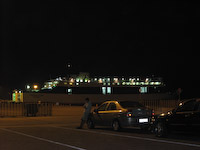 We ordered and Keleigh excused herself to the restroom. After what seemed to be an extraordinary long time at the restroom
I went inside to ask the waiter if he had seen her—he had not. As I was talking to him I
heard her faint voice calling my name in distress. In an instant I was outside the bathroom door, she was desperate and
crying; still not knowing exactly what was going on I was ready to break down the door just as she pushed the key under the door.
I unlocked the door and she came out visibly distraught.
Apparently the vintage lock was jammed and she could not unlock from the inside.
She knocked and yelled, she even got on the toilet seat and yelled out the open window which to her
dismay was too small for her to climb out. Finally she resigned to just sitting on the toilet waiting to hear someone
walk by or see a shadow through the keyhole, or for me to realize that something was wrong.
Too bad the door lock did not play nice because the food was quite good.
We ordered and Keleigh excused herself to the restroom. After what seemed to be an extraordinary long time at the restroom
I went inside to ask the waiter if he had seen her—he had not. As I was talking to him I
heard her faint voice calling my name in distress. In an instant I was outside the bathroom door, she was desperate and
crying; still not knowing exactly what was going on I was ready to break down the door just as she pushed the key under the door.
I unlocked the door and she came out visibly distraught.
Apparently the vintage lock was jammed and she could not unlock from the inside.
She knocked and yelled, she even got on the toilet seat and yelled out the open window which to her
dismay was too small for her to climb out. Finally she resigned to just sitting on the toilet waiting to hear someone
walk by or see a shadow through the keyhole, or for me to realize that something was wrong.
Too bad the door lock did not play nice because the food was quite good.
To avoid late night heroics I called a few hotels while on the ferry and reserved a room at Zante Park Best Western Hotel. Upon arrival on the island we checked one other hotel option, which was a dive, before heading south towards Laganas/Λαγανάς for Zante Park. Large corporate owned hotels are not my cup of tea, but at 23:30 with a couple of cranky women something had to give. We drove through the main street of Laganas/Λαγανάς, a strip full of clubs, loud music, and tourist shops; this is where British package-holiday tourists descend en masse. Laganas/Λαγανάς beach is also among the only remaining habitats of the endangered loggerhead turtle Caretta Caretta. During summer the turtles crawl out of the sea to lay their eggs on the soft sand beach. Sea turtles nest where they were hatched and the turtles have been returning to Laganas/Λαγανάς for more than 10,000 years. Unfortunately in the early 80s the tourist industry discovered the island and within ten years the intense tourist madness converted the beachfront into a strip of bars, restaurants, and hotels. Confused by the lights and loud music the number of returning turtles has been cut in half—thankfully Greece and the EU have taken steps to protect them.
Day 8
Zakynthos/Ζάκυνθος
We woke up late and left Laganas/Λαγανάς behind right after breakfast and a stop at a Super Market for fruits. Perhaps this is the playground of the player looking to score 22 year old northern European chicks, but be warned most girls here are from the Perfidious Albion.
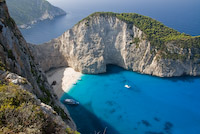 Our first stop was at one of the most famous beaches in Greece, the Shipwreck/Ναυάγιο,
an isolated sandy cove on the north-west shore of the island.
It's particularly striking because of the steep limestone cliff, white sand beach, and clear blue water.
Our first stop was at one of the most famous beaches in Greece, the Shipwreck/Ναυάγιο,
an isolated sandy cove on the north-west shore of the island.
It's particularly striking because of the steep limestone cliff, white sand beach, and clear blue water.
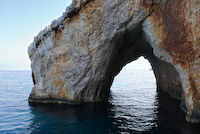 It is also home to the wreck of the alleged smuggler ship
Panagiotis/ΠαναγιώτηςThe most commonly accepted story regarding the wreck of the Panagiotis/Παναγιώτης
maintains that she spent the later part of her life as a smuggler ship.
In 1980, during a time of record population lows on the island of Zakynthos/Ζάκυνθος,
Panagiotis/Παναγιώτης was making her way
from Turkey with a freight of contraband cigarettes for the Italian Mafia, as some versions of the story assert.
The crew was suspected by authorities, and so the ship was pursued by the Greek Navy.
Encountering stormy weather, she ran aground in a shallow cove to the north of
Porto Vromi/Πόρτο Βρώμη, where the crew abandoned ship to evade the pursuing Navy.
To this day, she remains at the site..
The beach is accessible only by boat, the view from the platform atop the limestone cliff is equally stunning
as the view from sea level.
Our next stop was at Agios Nikolaos/Άγιος Νικόλαος to catch a boat for the
Shipwreck/Ναυάγιο and the Blue Caves/Γαλάζιες Σπηλιές.
I have been fortunate to experience many beautiful beaches across the seven seas—the
Shipwreck/Ναυάγιο beach is simply the most amazing of all, it seduces you
into a visual experience that can only be appreciated in person.
On the way back we stopped at the Blue Caves/Γαλάζιες Σπηλιές, a
series of natural arches famous for their azure color.
We took a dive in the idyllic waters in and around the caves, and our captain was ballzy
to take the boat through one of the arches; the boat was probably not his!
It is also home to the wreck of the alleged smuggler ship
Panagiotis/ΠαναγιώτηςThe most commonly accepted story regarding the wreck of the Panagiotis/Παναγιώτης
maintains that she spent the later part of her life as a smuggler ship.
In 1980, during a time of record population lows on the island of Zakynthos/Ζάκυνθος,
Panagiotis/Παναγιώτης was making her way
from Turkey with a freight of contraband cigarettes for the Italian Mafia, as some versions of the story assert.
The crew was suspected by authorities, and so the ship was pursued by the Greek Navy.
Encountering stormy weather, she ran aground in a shallow cove to the north of
Porto Vromi/Πόρτο Βρώμη, where the crew abandoned ship to evade the pursuing Navy.
To this day, she remains at the site..
The beach is accessible only by boat, the view from the platform atop the limestone cliff is equally stunning
as the view from sea level.
Our next stop was at Agios Nikolaos/Άγιος Νικόλαος to catch a boat for the
Shipwreck/Ναυάγιο and the Blue Caves/Γαλάζιες Σπηλιές.
I have been fortunate to experience many beautiful beaches across the seven seas—the
Shipwreck/Ναυάγιο beach is simply the most amazing of all, it seduces you
into a visual experience that can only be appreciated in person.
On the way back we stopped at the Blue Caves/Γαλάζιες Σπηλιές, a
series of natural arches famous for their azure color.
We took a dive in the idyllic waters in and around the caves, and our captain was ballzy
to take the boat through one of the arches; the boat was probably not his!
Eventually we made it back to Xora/Χώρα for dinner at Akti/Ακτή since the recommended Arekia/Αρέκια and Alevizos/Αλεβίζος were not open yetGreeks eat late.. Other than the olives on the salad Akti/Ακτή turned out to be a fine choice for satisfying our appetite after a long day at sea. Following dinner we discovered Erietta Luxury Suites, a little paradise at Akrotiri/Ακρωτήρι. We settled in and managed a dive at the pool before dusk. At night we drove back to Xora/Χώρα for shopping at a bakery and a fruit shop for the usual goodies.
Day 9
Zakynthos/Ζάκυνθος
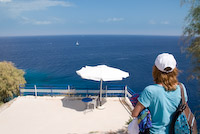 Anna/Άννα took a dip at the pool while we were still asleep.
After breakfast we decided to go back to the Blue Caves/Γαλάζιες Σπηλιές, this time by car.
It was still a good experience but it's best to hire a small boat and enjoy it by sea.
The waters were rather choppy so instead of swimming there we looked
for a more sheltered beach, and found a secluded rocky inlet 1 Km north of Agios Nikolaos/Άγιος Νικόλαος.
Other than the crystal clear waters, we discovered a small cave half submerged in water. Part scene
from a pirate movie, part from a romantic adventure, we wondered inside but did not find a
hidden treasure, pity.
Back at Erietta I talked with the owner and learned about his business. He invited us for a barbecue, but
we opted to return to Xora/Χώρα for dinner at the highly recommended Alevizos/Αλεβίζος;
it did not disappoint, the rooster, rabbit, giant beans, and village salad were magnificent. For desert
we had ice-cream at Dodoni/Δωδώνη, unfortunately it wasn't in the same league
as Gelatomania at Psirri/Ψυρρή, not even close.
I paid one last visit to the hotel's bar chatting with the barman and a couple of British lads
before settling in front of the TV for a memorable night of European football until
the wee hours.
Anna/Άννα took a dip at the pool while we were still asleep.
After breakfast we decided to go back to the Blue Caves/Γαλάζιες Σπηλιές, this time by car.
It was still a good experience but it's best to hire a small boat and enjoy it by sea.
The waters were rather choppy so instead of swimming there we looked
for a more sheltered beach, and found a secluded rocky inlet 1 Km north of Agios Nikolaos/Άγιος Νικόλαος.
Other than the crystal clear waters, we discovered a small cave half submerged in water. Part scene
from a pirate movie, part from a romantic adventure, we wondered inside but did not find a
hidden treasure, pity.
Back at Erietta I talked with the owner and learned about his business. He invited us for a barbecue, but
we opted to return to Xora/Χώρα for dinner at the highly recommended Alevizos/Αλεβίζος;
it did not disappoint, the rooster, rabbit, giant beans, and village salad were magnificent. For desert
we had ice-cream at Dodoni/Δωδώνη, unfortunately it wasn't in the same league
as Gelatomania at Psirri/Ψυρρή, not even close.
I paid one last visit to the hotel's bar chatting with the barman and a couple of British lads
before settling in front of the TV for a memorable night of European football until
the wee hours.
Day 10
Kefalonia/Κεφαλλονιά
Tired from the sleepless night before yet satisfied since all the Greek soccer teams won, we were up annoyingly early to catch the 9:45 ferry from Agios Nikolaos/Άγιος Νικόλαος for the short hop north to Pesada/Πεσάδα in Kefalonia/Κεφαλλονιά; predictably the girls were fresh and peachy.
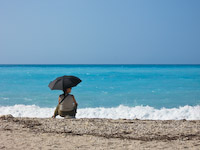 There is something about the tranquility being atop a high mountain on a Greek island that's
just too much to pass up, fresh off the ferry we ascended 1000m over Mt. Ainos/Αίνος, the highest mountain on the island.
Perhaps it's the isolation, the lone faithful priest at his small church, the breeze,
the view, or the brief getaway to a higher place close to the Greek Gods. It's a different world, not as picturesque
as the blue waters down below, but with a charm of it's own. More adventure awaited us north, so we descended and headed
to the famous Melissani/Μελισσάνη lake.
The lake lies inside a cave whose roof partially collapsed, and although it is just 500m from the sea, its
crystal clear water is a meter higher than sea level and is brackish–a mixture of sea and sweet water
that rises from a 30m deep cave system and flows silently into the lake and through
narrow crevices all the way to the small circular lake at Karavomylos/Καραβόμυλος
and into the sea. We went around the main hall on a small boat and then passed
through a narrow channel to a second huge cavern with an arched roof
which was also formed by a collapse. Although not as dramatic as the Diros/Διρός cave, it's impressive
and worth the visit.
There is something about the tranquility being atop a high mountain on a Greek island that's
just too much to pass up, fresh off the ferry we ascended 1000m over Mt. Ainos/Αίνος, the highest mountain on the island.
Perhaps it's the isolation, the lone faithful priest at his small church, the breeze,
the view, or the brief getaway to a higher place close to the Greek Gods. It's a different world, not as picturesque
as the blue waters down below, but with a charm of it's own. More adventure awaited us north, so we descended and headed
to the famous Melissani/Μελισσάνη lake.
The lake lies inside a cave whose roof partially collapsed, and although it is just 500m from the sea, its
crystal clear water is a meter higher than sea level and is brackish–a mixture of sea and sweet water
that rises from a 30m deep cave system and flows silently into the lake and through
narrow crevices all the way to the small circular lake at Karavomylos/Καραβόμυλος
and into the sea. We went around the main hall on a small boat and then passed
through a narrow channel to a second huge cavern with an arched roof
which was also formed by a collapse. Although not as dramatic as the Diros/Διρός cave, it's impressive
and worth the visit.
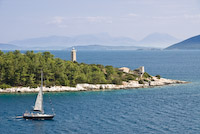 Next stop was at Myrtos/Μύρτος beach for a swim but the high waves were too much for everybody but
a few brave (stupid?) souls myself included. We continued north to the town of Assos/Άσσος in search
of accommodations for the night–we found a cute Dalmatian, similar to our
Holley,
but no place to stay. The Greeks say
“every misfortune is for good” and at the end we were glad we didn't find anything until
Fiskardo/Φισκάρδο, a seaside village at the north tip of the island.
We immediately found the Lighthouse Lofts
situated on top of the hill with a gorgeous view of the harbor. After settling in we walked to the
harbor where dozens of sailboats were docked in front of the small shops and restaurants.
Fiskardo/Φισκάρδο's harbor is small and idyllic, perhaps the best spot to have dinner and relax
of the entire trip. We ate at Vassos, decent food but the famous
Tasia/Τασία restaurant is probably a better bet.
Next stop was at Myrtos/Μύρτος beach for a swim but the high waves were too much for everybody but
a few brave (stupid?) souls myself included. We continued north to the town of Assos/Άσσος in search
of accommodations for the night–we found a cute Dalmatian, similar to our
Holley,
but no place to stay. The Greeks say
“every misfortune is for good” and at the end we were glad we didn't find anything until
Fiskardo/Φισκάρδο, a seaside village at the north tip of the island.
We immediately found the Lighthouse Lofts
situated on top of the hill with a gorgeous view of the harbor. After settling in we walked to the
harbor where dozens of sailboats were docked in front of the small shops and restaurants.
Fiskardo/Φισκάρδο's harbor is small and idyllic, perhaps the best spot to have dinner and relax
of the entire trip. We ate at Vassos, decent food but the famous
Tasia/Τασία restaurant is probably a better bet.
Day 11
Ithaki/Ιθάκη
After a late morning breakfast we took a dive at the crystal clear waters of Antisamos/Αντίσαμος beach, just east of the town of Sami/Σάμη which is where we took the 15:15 ferry for Ithaki/Ιθάκη.
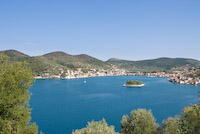 Home of the mythological hero Odysseus/Οδυσσέας,
Ithaki/ΙθάκηAlso known as Ithaca or Ithaka.
is a small, calm, off the beaten path island
that offers routes with great views and majestic little bays with clear water. We arrived to the capital
Vathy/Βαθύ which has an impressive fiord with a
small island, Lazareto/Λαζαρέτο, in the middle.
We wanted to hire a boat to take us to the famous Gidaki/Γιδάκι beach
but apparently there was a wedding at the church on Lazareto/Λαζαρέτο island and the only available boat was already
hired to carry people to and from the small island. We threw the dice and went
towards Filiatro/Φιλιατρό beach to find a place for the night.
The beach was nice, but the hotel situation was not looking good. When in doubt, go north! that had served us well
so far, so we drove to Frikes/Φρίκες but our hopes for a four star hotel were too high
for this little island. We settled at the small pensione Kapetanios/Καπετάνιος
at the nearby village of Kioni/Κιόνι. When it comes to choices Ithaki/Ιθάκη
does not have many, but it does have charm. Dinner at Calypso/Καλυψώ
by the seaside at Kioni/Κιόνι was fabulous, highly recommended.
Home of the mythological hero Odysseus/Οδυσσέας,
Ithaki/ΙθάκηAlso known as Ithaca or Ithaka.
is a small, calm, off the beaten path island
that offers routes with great views and majestic little bays with clear water. We arrived to the capital
Vathy/Βαθύ which has an impressive fiord with a
small island, Lazareto/Λαζαρέτο, in the middle.
We wanted to hire a boat to take us to the famous Gidaki/Γιδάκι beach
but apparently there was a wedding at the church on Lazareto/Λαζαρέτο island and the only available boat was already
hired to carry people to and from the small island. We threw the dice and went
towards Filiatro/Φιλιατρό beach to find a place for the night.
The beach was nice, but the hotel situation was not looking good. When in doubt, go north! that had served us well
so far, so we drove to Frikes/Φρίκες but our hopes for a four star hotel were too high
for this little island. We settled at the small pensione Kapetanios/Καπετάνιος
at the nearby village of Kioni/Κιόνι. When it comes to choices Ithaki/Ιθάκη
does not have many, but it does have charm. Dinner at Calypso/Καλυψώ
by the seaside at Kioni/Κιόνι was fabulous, highly recommended.
Day 12
Lefkada/Λευκάδα
We took the 11:15 ferry from Frikes/Φρίκες to the island of Lefkada/Λευκάδα
arriving at the small village of Vasiliki/Βασιλική.
Lefkada/Λευκάδα is known, at least amongst Greeks,
for its beautiful beaches so not surprisingly
our first stop was at the impressive
Egremni/Εγκρεμνοί, a remote beach you can barely get to by car that requires
descending 250 steps over a steep cliff down to the water.
Not in the mood for such hike, we skipped it in favor of Porto Katsiki/Πόρτο Κατσίκι,
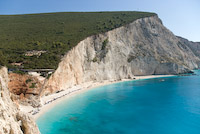 an equally impressive beach a few kilometers south
of Egremni/Εγκρεμνοί.
There are concession stands near the parking teasing your nose with
freshly charcoal grilled souvlaki/σουβλάκι, not that you'd want to eat before swimming.
The green-blue water color has stunning clarity and the pebbly beach is unspoiled despite its popularity.
After thoroughly enjoying the water we drove north to St. Nikita/Άγιο Νικήτα
where we quickly found Hotel St. Nikitas/Άγιο Νικήτας
and settled in. The hostess suggested To Agnantio/ΤΆγνάντιο for dinner,
which we found hidden off the main street where most of the town's restaurants were.
To Agnantio/ΤΆγνάντιο was empty and seemed sketchy but in Greece you can't always judge the book by
its cover, and this turned out to be a prime example. The food was out of this world, perhaps the best
of the trip, so far. Back at the hotel I had another late night session watching the
legendary Greek TV show Athletic Sunday/Αθλητική ΚυριακήAt over 35 consecutive years on air, it's the longest running show on Greek TV.
for a recap of the weekend's soccer action–my
team Olympiakos/Ολυμπιακός won easily 6-2 against
OFH/ΟΦΗ.
an equally impressive beach a few kilometers south
of Egremni/Εγκρεμνοί.
There are concession stands near the parking teasing your nose with
freshly charcoal grilled souvlaki/σουβλάκι, not that you'd want to eat before swimming.
The green-blue water color has stunning clarity and the pebbly beach is unspoiled despite its popularity.
After thoroughly enjoying the water we drove north to St. Nikita/Άγιο Νικήτα
where we quickly found Hotel St. Nikitas/Άγιο Νικήτας
and settled in. The hostess suggested To Agnantio/ΤΆγνάντιο for dinner,
which we found hidden off the main street where most of the town's restaurants were.
To Agnantio/ΤΆγνάντιο was empty and seemed sketchy but in Greece you can't always judge the book by
its cover, and this turned out to be a prime example. The food was out of this world, perhaps the best
of the trip, so far. Back at the hotel I had another late night session watching the
legendary Greek TV show Athletic Sunday/Αθλητική ΚυριακήAt over 35 consecutive years on air, it's the longest running show on Greek TV.
for a recap of the weekend's soccer action–my
team Olympiakos/Ολυμπιακός won easily 6-2 against
OFH/ΟΦΗ.
Day 13
Parga/Πάργα
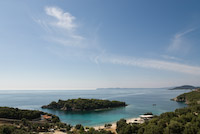 We had a light breakfast and started relatively late, at 10:15, the drive towards
Igoumenitsa/Ηγουμενίτσα, where we would hop on the ferry for Kerkyra/Κέρκυρα.
The lagoons of northern Lefkada/Λευκάδα before passing the small bridge onto the mainland Greece
are quite interesting, there we saw what must be the world's smallest inhabited islet with a house on it!
After the pretty but touristy Parga/Πάργα we passed through the busy
Valtos/Βάλτος beach and on to the picturesque Sarakiniko/Σαρακήνικο
where we made a wrong right turn that eventually lead us to the beach through a bone jarring gravel road.
I let the girls at beach and drove back to take the left turn, which was a much smoother road that lead to a
small parking lot at the other side of the beach. Even my sense of awareness is sometimes defeated, regardless,
it was worth the effort as the water there was fabulous. The rest of the way to Igoumenitsa/Ηγουμενίτσα
was full of pretty secluded beaches. We arrived at 15:11, just in time for the 15:15 ferry, we literally
paid, drove onto the boat, and departed for Kerkyra/Κέρκυρα.
We had a light breakfast and started relatively late, at 10:15, the drive towards
Igoumenitsa/Ηγουμενίτσα, where we would hop on the ferry for Kerkyra/Κέρκυρα.
The lagoons of northern Lefkada/Λευκάδα before passing the small bridge onto the mainland Greece
are quite interesting, there we saw what must be the world's smallest inhabited islet with a house on it!
After the pretty but touristy Parga/Πάργα we passed through the busy
Valtos/Βάλτος beach and on to the picturesque Sarakiniko/Σαρακήνικο
where we made a wrong right turn that eventually lead us to the beach through a bone jarring gravel road.
I let the girls at beach and drove back to take the left turn, which was a much smoother road that lead to a
small parking lot at the other side of the beach. Even my sense of awareness is sometimes defeated, regardless,
it was worth the effort as the water there was fabulous. The rest of the way to Igoumenitsa/Ηγουμενίτσα
was full of pretty secluded beaches. We arrived at 15:11, just in time for the 15:15 ferry, we literally
paid, drove onto the boat, and departed for Kerkyra/Κέρκυρα.
Kerkyra/Κέρκυρα
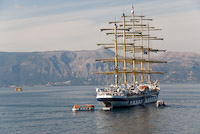 Upon arrival on the island we cruised around the town of Corfu before leaving for
Palaiokastritsa/Παλαιοκαστρίτσα in search of accommodations.
We found nothing and I decided, against all advice (read: nagging) to ascend the steep mountain
towards Lakones/Λάκωνες. The view was magnificent, however
the one hotel we checked out, Golden Fox, was anything but golden, so once again we descended the mountain
and drove south, seemingly at random. We were in the middle of nowhere with the night approaching fast,
yet I was obsessed with finding the village of Ermones/Έρμονες.
Out of nowhere we found a small travel agency;
I asked where on the island we can find the best hotel, and to my delight the agent smiled
and pointed towards the beach to Ermones Golf Palace. Bingo! The royal suite was available
and within minutes we were enjoying the sunset from the balcony.
Upon arrival on the island we cruised around the town of Corfu before leaving for
Palaiokastritsa/Παλαιοκαστρίτσα in search of accommodations.
We found nothing and I decided, against all advice (read: nagging) to ascend the steep mountain
towards Lakones/Λάκωνες. The view was magnificent, however
the one hotel we checked out, Golden Fox, was anything but golden, so once again we descended the mountain
and drove south, seemingly at random. We were in the middle of nowhere with the night approaching fast,
yet I was obsessed with finding the village of Ermones/Έρμονες.
Out of nowhere we found a small travel agency;
I asked where on the island we can find the best hotel, and to my delight the agent smiled
and pointed towards the beach to Ermones Golf Palace. Bingo! The royal suite was available
and within minutes we were enjoying the sunset from the balcony.
For dinner we stayed at Ermones Golf Palace, every night they offered a satisfying buffet with a mix of western European and Greek food.
Day 14
Kerkyra/Κέρκυρα
We had breakfast at the hotel and later drove to Corfu. Once we found parking, which was more
difficult than any other island,
we walked through the labyrinth of the old city's narrow streets which are paved with cobblestones,
sometimes tortuous but colorful and clean.
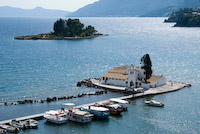 These streets are known as kantounia/καντούνια,
and the older amongst them sometimes follow the gentle irregularities of the ground; many
are too narrow for vehicular traffic.
A promenade rises by the seashore towards the bay
of Garitsa/Γαρίτσα,
together with an esplanadeThe largest in the Balkans.
between the town and
the citadel known as Spianada/Σπιανάδα where restaurants and bistros abound.
Somewhere in this maze we stumbled upon the
church of St. Spyridona/Αγ. Σπυρίδωνα
which has the relics of Saint Spyridon/Αγιο Σπυρίδων dating back many centuries.
Last, but not least, we drove to Kanoni/Κανόνι to view the iconic
monastery of Vlaherna/Βλαχέρνας which is build on a tiny island that's
linked to mainland by a cement dock. Nearby is Pontikonisi/Ποντικονήσι,
a small island with the byzantine church of
Pantokratora/Παντοκράτορα on it.
According to legend, this was the ship of Phaiakes/Φαιάκες
that was petrified after taking Odysseus/Οδυσσέας to Ithaki/Ιθάκη.
Another legend claims that this is the rock where Odysseus/Οδυσσέας's ship crashed during a storm.
Pontikonisi/Ποντικονήσι is considered the trademark of the island and is featured in many postcards.
These streets are known as kantounia/καντούνια,
and the older amongst them sometimes follow the gentle irregularities of the ground; many
are too narrow for vehicular traffic.
A promenade rises by the seashore towards the bay
of Garitsa/Γαρίτσα,
together with an esplanadeThe largest in the Balkans.
between the town and
the citadel known as Spianada/Σπιανάδα where restaurants and bistros abound.
Somewhere in this maze we stumbled upon the
church of St. Spyridona/Αγ. Σπυρίδωνα
which has the relics of Saint Spyridon/Αγιο Σπυρίδων dating back many centuries.
Last, but not least, we drove to Kanoni/Κανόνι to view the iconic
monastery of Vlaherna/Βλαχέρνας which is build on a tiny island that's
linked to mainland by a cement dock. Nearby is Pontikonisi/Ποντικονήσι,
a small island with the byzantine church of
Pantokratora/Παντοκράτορα on it.
According to legend, this was the ship of Phaiakes/Φαιάκες
that was petrified after taking Odysseus/Οδυσσέας to Ithaki/Ιθάκη.
Another legend claims that this is the rock where Odysseus/Οδυσσέας's ship crashed during a storm.
Pontikonisi/Ποντικονήσι is considered the trademark of the island and is featured in many postcards.
We spent the afternoon at Achilleion/Αχίλλειον, a beautiful palace designed with the mythical hero Achilles/Αχιλλεύς as its central theme, it was built in 1890 by Empress of Austria Elisabeth of Bavaria. Elisabeth spoke Greek better than any of the Greek queens that were her contemporaries and she expressed a desire to further immerse herself in the Greek culture. Like other European royals, she had some Byzantine emperors among her distant ancestors. The palace and its gardens are magnificent, highly recommended for anyone visiting Kerkyra/Κέρκυρα.
Day 15
Kerkyra/Κέρκυρα
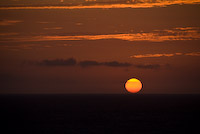 We woke up to the unusual sight of an angry sea viciously attacking the beach
and the umbrellas on it just beneath our room which overlooked the water. Later
the rain joined the wind to make for a hostile sightseeing day, nevertheless
we left after breakfast determined to navigate through the mess to
the town of Sidari/Σιδάρι at the north edge of
the islandAside from the weather, the road was a mess too..
The rain stopped just enough for us to we walk to the famous Canal d'AmourChannel of Love.
beach, a peculiar collection of small fiord like narrow inlets. It is said that if a couple
swims through the channels they will be together for ever. Unfortunately it was too chilly for a swim,
but it was worth the drive for photos.
We were running low on Euros so we drove to the town of Acharavi/Αχαράβη
to exchange travelers cheques. We arrived at Emporiki/Εμπορική bank
at 14:05 only to be told by the paper pushers that they could not exchange travelers cheques after 14:00.
Whatever. We found an Alpha Bank that was happy to take our money and give us Euros.
The miserable weather had taken a toll on everybody so we cut the day short and returned to the hotel
for some R&R.
We woke up to the unusual sight of an angry sea viciously attacking the beach
and the umbrellas on it just beneath our room which overlooked the water. Later
the rain joined the wind to make for a hostile sightseeing day, nevertheless
we left after breakfast determined to navigate through the mess to
the town of Sidari/Σιδάρι at the north edge of
the islandAside from the weather, the road was a mess too..
The rain stopped just enough for us to we walk to the famous Canal d'AmourChannel of Love.
beach, a peculiar collection of small fiord like narrow inlets. It is said that if a couple
swims through the channels they will be together for ever. Unfortunately it was too chilly for a swim,
but it was worth the drive for photos.
We were running low on Euros so we drove to the town of Acharavi/Αχαράβη
to exchange travelers cheques. We arrived at Emporiki/Εμπορική bank
at 14:05 only to be told by the paper pushers that they could not exchange travelers cheques after 14:00.
Whatever. We found an Alpha Bank that was happy to take our money and give us Euros.
The miserable weather had taken a toll on everybody so we cut the day short and returned to the hotel
for some R&R.
Day 16
Zagoroxoria/Ζαγωροχώρια
We got up early to catch the 8:30 ferry for Igoumenitsa/Ηγουμενίτσα, which is where the Egnatia/Εγνατία highway begins and spans all of northern Greece on the way to Turkey. It was a bit of a challenge to find the entrance for the highway because there were no signs for it, but after some circling around we eventually found it and we were on our way to Thessaloniki/Θεσσαλονίκη. Unfortunately at that time Egnatia/Εγνατία was about 70% completeThe project began in the 1990s, but because it crosses the Pindos/Πίνδος and Vermio/Βέρμιο mountains, construction has been plagued with delays because of the formidable engineering challenges. When completed, its full length will include 76 tunnels whose combined length will total 99km, and 1650 bridges! so at Ioannina/Ιωάννινα we had to get off the highway. Since we were onto side roads anyway, I decided it was worth taking a detour to the picturesque region of Zagoroxoria/Ζαγωροχώρια, a collection of 45 villages high up in the mountains north of Ioannina/Ιωάννινα. Because of the mountainous terrain, access is difficult, a positive factor conducive to security and stability thought history. In contrast to the rest of Greece, which witnessed the passage of one conqueror after another, Zagoroxoria/Ζαγωροχώρια only heard the distant rumble of the rise and fall of empires; there were no invasions or forcible changes in the composition of its population. Our first stop was on the way to Small Papigko/Μικρό Πάπιγκο at the small bridge crossing the river Voidomatis/Βοιδομάτης. This river is supposed to be one of the cleanest in Europe; its source supply is Vikos/Βίκος gorge in the foothill of Vikos/Βίκος village where underground springs gush out and supply it continuously.
Just before Small Papigko/Μικρό Πάπιγκο on the left is
Kolympithres/Κολυμπίθρες, a stunning phenomenon of
naturally carved small and large granite pools filled with crystal clear cold water from the
stream flowing down the mountain. The villagers have even built a small dam; during the summer
months they close the gate and let the water fill a large swimming pool like area where visitors
can cool off.
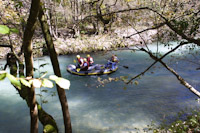 Our next stop was Monodendri/Μονοδέντρι and the monastery
of St. Paraskevi/Αγ. Παρασκευή at the edge of
Vikos/Βίκος gorge which, according to the
Guinness book of world records,
is the deepest canyon in the world. The view from the monastery's small balcony is dizzying, but for
an even greater adrenaline rush we took the trail just behind the monastery by the edge of the canyon where
we were literally walking within a meter from the edge of abyss. The first part of the trail took us over
a wooden plank, which I call the leap of faith, if the plank breaks while you are on it, you can close
your eyes and enjoy the free fall down the canyon. If you continue on the path the trail becomes impossibly
narrow, less than a few centimeters wide and effectively ends. If you climb over the side of the mountain
there is another trail that continues on. We took it all the way to a stone gate, which according to local
legend was the entrance to a hideout during the Ottoman occupation. Although the trail continues on, we decided
to stop there and enjoy the vista. Here is a
short videoTo play this MPEG-4 video use one of the following players: Windows Media Player 12 or above, Quicktime Player 7 or above , VLC 1 or above.
on this trail.
Our next stop was Monodendri/Μονοδέντρι and the monastery
of St. Paraskevi/Αγ. Παρασκευή at the edge of
Vikos/Βίκος gorge which, according to the
Guinness book of world records,
is the deepest canyon in the world. The view from the monastery's small balcony is dizzying, but for
an even greater adrenaline rush we took the trail just behind the monastery by the edge of the canyon where
we were literally walking within a meter from the edge of abyss. The first part of the trail took us over
a wooden plank, which I call the leap of faith, if the plank breaks while you are on it, you can close
your eyes and enjoy the free fall down the canyon. If you continue on the path the trail becomes impossibly
narrow, less than a few centimeters wide and effectively ends. If you climb over the side of the mountain
there is another trail that continues on. We took it all the way to a stone gate, which according to local
legend was the entrance to a hideout during the Ottoman occupation. Although the trail continues on, we decided
to stop there and enjoy the vista. Here is a
short videoTo play this MPEG-4 video use one of the following players: Windows Media Player 12 or above, Quicktime Player 7 or above , VLC 1 or above.
on this trail.
After a pit stop at the small eatery Grandma's Secrets/Τα Μυστικά της Γιαγιάς for chicken and mushroom pies, we left for Ioannina/Ιωάννινα to get back onto the Egnatia/Εγνατία highway. Unfortunately the highway after Ioannina/Ιωάννινα was not finished, so we had to drive back and proceed to Metsovo/Μέτσοβο via Perama/Πέραμα. Just before Metsovo/Μέτσοβο at Kryoneri/Κρυονέρι the highway was finished, but it only lasted for about 10Km. We continued towards Grevena/Γρεβενά where we finally reentered the Egnatia/Εγνατία highway for good, all the way to Thessaloniki/Θεσσαλονίκη where we picked up the keys to the beach house and immediately left for Halkidiki/Χαλκιδική. We arrived to the beach house near midnight; there was no grocery store open so we went to bed tired and hungry, but at last we were back home.
Day 17
Halkidiki/Χαλκιδική
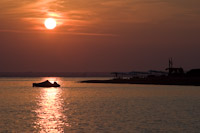 One of my favorite bakeries in Greece is at Polygyros/ΠολύγυροςPolygyros/Πολύγυρος in Greek means many turns because the road to and from the town has countless
switchbacks. In the early 1990s it was connected to the port town of Gerakini/Γερακινή
by a modern highway, nevertheless the road north of Polygyros/Πολύγυρος is still treacherous., a
pretty town high on the south west side of Mt. Holomontas/Χολομώντας
overlooking the north Agean.
It's a relatively short and interesting drive from the beach house so we went early in the morning to stock up on freshly
baked bread, the incomparable Berioti/Βεριώτη yogurt, and the veritable Greek chocolate
spread Merenta/Μερέντα. We were so hungry the bread was mauled
prior to breakfast at the house.
Although I was eager to explore the beauties of Sithonia/Σιθωνία, the middle
peninsula of Halkidiki/Χαλκιδική and one of the hidden treasures of Greece, Keleigh was still exhausted from
the prior day so we relaxed at a beach near Gerakini/Γερακινή, close to the house.
We had dinner at the excellent Six Fountains/Έξι Βρύσες restaurant at
Polygyros/Πολύγυρος.
One of my favorite bakeries in Greece is at Polygyros/ΠολύγυροςPolygyros/Πολύγυρος in Greek means many turns because the road to and from the town has countless
switchbacks. In the early 1990s it was connected to the port town of Gerakini/Γερακινή
by a modern highway, nevertheless the road north of Polygyros/Πολύγυρος is still treacherous., a
pretty town high on the south west side of Mt. Holomontas/Χολομώντας
overlooking the north Agean.
It's a relatively short and interesting drive from the beach house so we went early in the morning to stock up on freshly
baked bread, the incomparable Berioti/Βεριώτη yogurt, and the veritable Greek chocolate
spread Merenta/Μερέντα. We were so hungry the bread was mauled
prior to breakfast at the house.
Although I was eager to explore the beauties of Sithonia/Σιθωνία, the middle
peninsula of Halkidiki/Χαλκιδική and one of the hidden treasures of Greece, Keleigh was still exhausted from
the prior day so we relaxed at a beach near Gerakini/Γερακινή, close to the house.
We had dinner at the excellent Six Fountains/Έξι Βρύσες restaurant at
Polygyros/Πολύγυρος.
Day 18
Halkidiki/Χαλκιδική
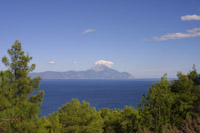 We had a quick breakfast at the house and then drove east to Vourvourou/Βουρβουρού
and walked along the beach at the small lagoon across from the
island of Diaporo/Διάπορο.
This island has a couple of gorgeous beaches that I have
visited by boat before, this time we did not have a boat so we drove a few kilometers south to
Armenistis/Αρμενιστής beach instead for a dip in its crystal clear blue waters.
The drive to Armenistis/Αρμενιστής and beyond is one of my favorites in Greece. That's because
most of Sithonia/Σιθωνία, especially its western part, is protected from
commercial development. Starting from
Vourvourou/Βουρβουρού all the way to Sarti/Σάρτη you can enjoy
the unspoiled beauty of raw nature. God must had been inspired when He created this land.
Although Armenistis/Αρμενιστής is gorgeous, the real treat is a few kilometers further south at
a place known as Kavourotrypes/Καβουρότρυπες. Thankfully it's not
marked, so this gem is somewhat secluded as it's only known to the locals and the most dedicated of
adventure seekers. We relaxed, dived, and played there for the remainder of the day.
For dinner we went further south to the town of Sarti/Σάρτη
and ate, upon recommendation of a local, at the excellent taverna Pyrofani/Πυροφάνι.
Highly recommended.
We had a quick breakfast at the house and then drove east to Vourvourou/Βουρβουρού
and walked along the beach at the small lagoon across from the
island of Diaporo/Διάπορο.
This island has a couple of gorgeous beaches that I have
visited by boat before, this time we did not have a boat so we drove a few kilometers south to
Armenistis/Αρμενιστής beach instead for a dip in its crystal clear blue waters.
The drive to Armenistis/Αρμενιστής and beyond is one of my favorites in Greece. That's because
most of Sithonia/Σιθωνία, especially its western part, is protected from
commercial development. Starting from
Vourvourou/Βουρβουρού all the way to Sarti/Σάρτη you can enjoy
the unspoiled beauty of raw nature. God must had been inspired when He created this land.
Although Armenistis/Αρμενιστής is gorgeous, the real treat is a few kilometers further south at
a place known as Kavourotrypes/Καβουρότρυπες. Thankfully it's not
marked, so this gem is somewhat secluded as it's only known to the locals and the most dedicated of
adventure seekers. We relaxed, dived, and played there for the remainder of the day.
For dinner we went further south to the town of Sarti/Σάρτη
and ate, upon recommendation of a local, at the excellent taverna Pyrofani/Πυροφάνι.
Highly recommended.
Day 19
Halkidiki/Χαλκιδική
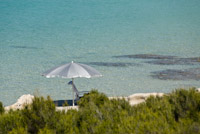 We decided to return to Kavourotrypes/Καβουρότρυπες for another day of relaxing by the water.
We supplied ourselves with food, drinks, and an umbrella at Nikiti/Νικήτη, and
then drove the same route as the previous day straight to
Kavourotrypes/Καβουρότρυπες where we spent all day–well worth it. For dinner we
first went to Agioneri/Αγιονέρι near Polygyros/Πολύγυρος
were I have eaten before; the food there is amazing but for some unknown reason it was closed,
so we went to
“La Skala” near the
Gerakina Beach hotel
in the small village of Gerakini/Γερακινή.
It had the tourist trap vibe, but the Syrian chef's food shattered any hint of doubt.
The food was truly excellent–I knew we would be returning since it's so close to
the house.
We decided to return to Kavourotrypes/Καβουρότρυπες for another day of relaxing by the water.
We supplied ourselves with food, drinks, and an umbrella at Nikiti/Νικήτη, and
then drove the same route as the previous day straight to
Kavourotrypes/Καβουρότρυπες where we spent all day–well worth it. For dinner we
first went to Agioneri/Αγιονέρι near Polygyros/Πολύγυρος
were I have eaten before; the food there is amazing but for some unknown reason it was closed,
so we went to
“La Skala” near the
Gerakina Beach hotel
in the small village of Gerakini/Γερακινή.
It had the tourist trap vibe, but the Syrian chef's food shattered any hint of doubt.
The food was truly excellent–I knew we would be returning since it's so close to
the house.
Day 20
Halkidiki/Χαλκιδική
Against my better judgement I agreed to a “do nothing” day, well almost nothing. We went to a secluded “beach”Club I, η χρυσή αλυσίδα!. If relaxing while reading 4T and listening to the ambient beach heaven is bum, guilty as charged.
Day 21
Halkidiki/Χαλκιδική
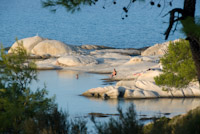 We couldn't help ourselves to just one last day at Kavourotrypes/Καβουρότρυπες.
Although there are hundreds, perhaps thousands of treasures around the Agean
requiring several lifetimes to explore, Sithonia/Σιθωνία is unique
in that it's close to Thessaloniki/Θεσσαλονίκη, is relatively unknown,
undeveloped, and off the beaten path. It's also right across from
Mt. Athos/Άγιον Όρος, the autonomous monastic state of the Holy Mountain,
and garden of the Mother of God.
According to tradition, Virgin Mary visited the peninsula and was
overwhelmed by the wild natural beauty of the mountain. She blessed it and asked
her Son for it to be her garden. Ever since it has been out of bounds to other women
and strictly a place of orthodox worship. I was fortunate to visit a few
of the west side monasteriesThere are twenty main monasteries constituting the Holy Community.
in the 1990s. This is an unspoiled place that the “modern” world has not invaded, it's a window
into the past and how life went on a millennium ago with simplicity and modesty.
A similar simplicity and modesty exists at Sithonia/Σιθωνία, particularly on its east side.
We couldn't help ourselves to just one last day at Kavourotrypes/Καβουρότρυπες.
Although there are hundreds, perhaps thousands of treasures around the Agean
requiring several lifetimes to explore, Sithonia/Σιθωνία is unique
in that it's close to Thessaloniki/Θεσσαλονίκη, is relatively unknown,
undeveloped, and off the beaten path. It's also right across from
Mt. Athos/Άγιον Όρος, the autonomous monastic state of the Holy Mountain,
and garden of the Mother of God.
According to tradition, Virgin Mary visited the peninsula and was
overwhelmed by the wild natural beauty of the mountain. She blessed it and asked
her Son for it to be her garden. Ever since it has been out of bounds to other women
and strictly a place of orthodox worship. I was fortunate to visit a few
of the west side monasteriesThere are twenty main monasteries constituting the Holy Community.
in the 1990s. This is an unspoiled place that the “modern” world has not invaded, it's a window
into the past and how life went on a millennium ago with simplicity and modesty.
A similar simplicity and modesty exists at Sithonia/Σιθωνία, particularly on its east side.
That night Panathinaikos/Παναθηναικός beat Artmedia Petrzalka 3-0 and continued on to the “UEFA cup”Later renamed: “UEFA Europa League”.!
Day 22
Thessaloniki/Θεσσαλονίκη
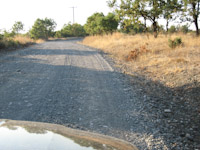 Getting up at 5am is not my favorite sport but we had a long day ahead of us. First stop was
Thessaloniki/Θεσσαλονίκη to drop off Anna/Άννα and pay a visit to the legendary
patisserie Terkenlis at
Tsimiski/Τσιμισκή street. Unfortunately my favorite
Vienna croissant/βιενέζικο κρουασάν was still in the oven at 06:30,
so we got apple, spinach, and cheese pies from a nearby shop, and began the trip to Meteora/Μετέωρα
on the Egnatia/Εγνατία highway.
Near Grevena/Γρεβενά we took a “shortcut”,
a treacherous gravel road that we mistakenly thought would merge back to civilization.
It never did, there was no soul around,
and we were lost in no man's land. Thankfully we found an oasis, the small village of
Pigaditsa/Πηγαδίτσα
where a kind man pointed us back towards the main road for Meteora/Μετέωρα.
Apparently the “shortcut” is only for serious off-roading!
Getting up at 5am is not my favorite sport but we had a long day ahead of us. First stop was
Thessaloniki/Θεσσαλονίκη to drop off Anna/Άννα and pay a visit to the legendary
patisserie Terkenlis at
Tsimiski/Τσιμισκή street. Unfortunately my favorite
Vienna croissant/βιενέζικο κρουασάν was still in the oven at 06:30,
so we got apple, spinach, and cheese pies from a nearby shop, and began the trip to Meteora/Μετέωρα
on the Egnatia/Εγνατία highway.
Near Grevena/Γρεβενά we took a “shortcut”,
a treacherous gravel road that we mistakenly thought would merge back to civilization.
It never did, there was no soul around,
and we were lost in no man's land. Thankfully we found an oasis, the small village of
Pigaditsa/Πηγαδίτσα
where a kind man pointed us back towards the main road for Meteora/Μετέωρα.
Apparently the “shortcut” is only for serious off-roading!
Meteora/Μετέωρα
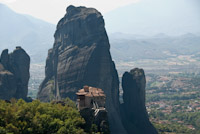 Despite the unexpected detour, we arrived at Meteora/Μετέωρα by 10:30, along with hundreds of other
visitors and tourist buses. Meteora/Μετέωρα is an amazing geological phenomenon, a set of rocky sculptures,
a work of art nature gave us to marvel at.
Hermit monks started to first settle here in the 12th century, and the first monasteries were built in the 14th
century. During the 16th century there were as many as 20 operational monasteries,
but infighting and disagreements that came about from claims to the available cultivable soil lead to
their decline and today only six monasteries remain in operation.
It is certainly one of the most spectacular sceneries in
Greece worth visiting even if you are not interested in the monasteries atop the towering rock formations.
Parking alongside the narrow roads leading up to the monasteries can be dodgy
but it's unavoidable since the parking lots are small and usually full.
Despite the unexpected detour, we arrived at Meteora/Μετέωρα by 10:30, along with hundreds of other
visitors and tourist buses. Meteora/Μετέωρα is an amazing geological phenomenon, a set of rocky sculptures,
a work of art nature gave us to marvel at.
Hermit monks started to first settle here in the 12th century, and the first monasteries were built in the 14th
century. During the 16th century there were as many as 20 operational monasteries,
but infighting and disagreements that came about from claims to the available cultivable soil lead to
their decline and today only six monasteries remain in operation.
It is certainly one of the most spectacular sceneries in
Greece worth visiting even if you are not interested in the monasteries atop the towering rock formations.
Parking alongside the narrow roads leading up to the monasteries can be dodgy
but it's unavoidable since the parking lots are small and usually full.
Athens/Αθήνα
We left for Athens at 15:30, the plan was to find a hotel in time for the Olympiakos/Ολυμπιακός away game with Werder Bremen in Germany. After the long drive we arrived once again at Amalia Hotel and settled in just in time for the game. It was an epic 3-1 win for Olympiakos/Ολυμπιακός. Nothing in my way; Breathless. In the ecstasy of the moment... I did a back flip in bed landing on my head! it hurt for weeks, but sweet oh sweet victory. Special thanks to Takis Lemonis/Τάκης Λεμονήςa.k.a Τάκαρος, Ieroklis Stoltidis/Ιεροκλής Στολτίδηςa.k.a Ιέρο, and the incomparable Predrag Djordjevic/Πρέντρακ Τζόρτζεβιτςa.k.a Τζόλε for the joy they gave us.
Day 23
Athens/Αθήνα
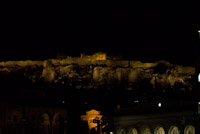 We spend all morning at Monastiraki/Μοναστηράκι shopping, mingling and experiencing the
Athenian agora. We couldn't resit returning to Platanos/Πλάτανος at Plaka/Πλάκα
for lunch. When it comes to food, if it
ain't broke, don't mess with it. Ice-cream, once again, at Gelatomania!
Among other things we wanted to buy good pastries so we asked locals for recommendations and
more than one person pointed as to a small Turkish store at Nikis/Νίκης street
near Syntagma square/Πλατεία Συντάγματος
(parallel to Voulis/Βουλής street
and perpendicular to Ermou/Ερμού street.) The sweets were very good,
but when you are used to delicacy perfection from Thessaloniki/Θεσσαλονίκη, it
kind of leaves you wanting for more–next time we'll either
ask my cousins/brother for better recommendations, or shop at the best of the best:
Hatzifotiou/Χατζηφωτίου.
We spend all morning at Monastiraki/Μοναστηράκι shopping, mingling and experiencing the
Athenian agora. We couldn't resit returning to Platanos/Πλάτανος at Plaka/Πλάκα
for lunch. When it comes to food, if it
ain't broke, don't mess with it. Ice-cream, once again, at Gelatomania!
Among other things we wanted to buy good pastries so we asked locals for recommendations and
more than one person pointed as to a small Turkish store at Nikis/Νίκης street
near Syntagma square/Πλατεία Συντάγματος
(parallel to Voulis/Βουλής street
and perpendicular to Ermou/Ερμού street.) The sweets were very good,
but when you are used to delicacy perfection from Thessaloniki/Θεσσαλονίκη, it
kind of leaves you wanting for more–next time we'll either
ask my cousins/brother for better recommendations, or shop at the best of the best:
Hatzifotiou/Χατζηφωτίου.
All the Greek soccer teams had another incredible European night, Aris/Άρης, AEK/ΑΕΚ, Larissa/Λάρισα, and Panionios/Πανιώνιος advanced and continued on to the “UEFA cup”Later renamed: “UEFA Europa League”.. Millions of soccer fans across Greece went to bed happy, I was one of them.
Day 24
Athens/Αθήνα
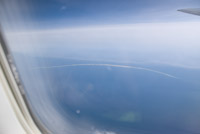 Anna/Άννα often calls me “Jovaisa” in honor of the Russian basketballer Sergėjus Jovaiša
who in Greece was dubbed
“last minute man” because of his last minute heroics in the 1987 European Basketball Championship.
Not to disappoint, I left packing at the last minute possible. Thankfully
our departure time was in the late afternoon so we didn't have to get up at an insanely early hour.
We did have to fight crazy traffic going to the airport, but we managed to get there just in time
to drop of the car to Christos/Χρήστος and catch our flight back home.
So there you have it, 24 days and 4,000km across Greece. I hope you enjoyed the ride.
Anna/Άννα often calls me “Jovaisa” in honor of the Russian basketballer Sergėjus Jovaiša
who in Greece was dubbed
“last minute man” because of his last minute heroics in the 1987 European Basketball Championship.
Not to disappoint, I left packing at the last minute possible. Thankfully
our departure time was in the late afternoon so we didn't have to get up at an insanely early hour.
We did have to fight crazy traffic going to the airport, but we managed to get there just in time
to drop of the car to Christos/Χρήστος and catch our flight back home.
So there you have it, 24 days and 4,000km across Greece. I hope you enjoyed the ride.
They say all good things come to an end, but this one never ends, it's just another chapter to the story. As dad used to say, “one lifetime is not enough to experience it all.”